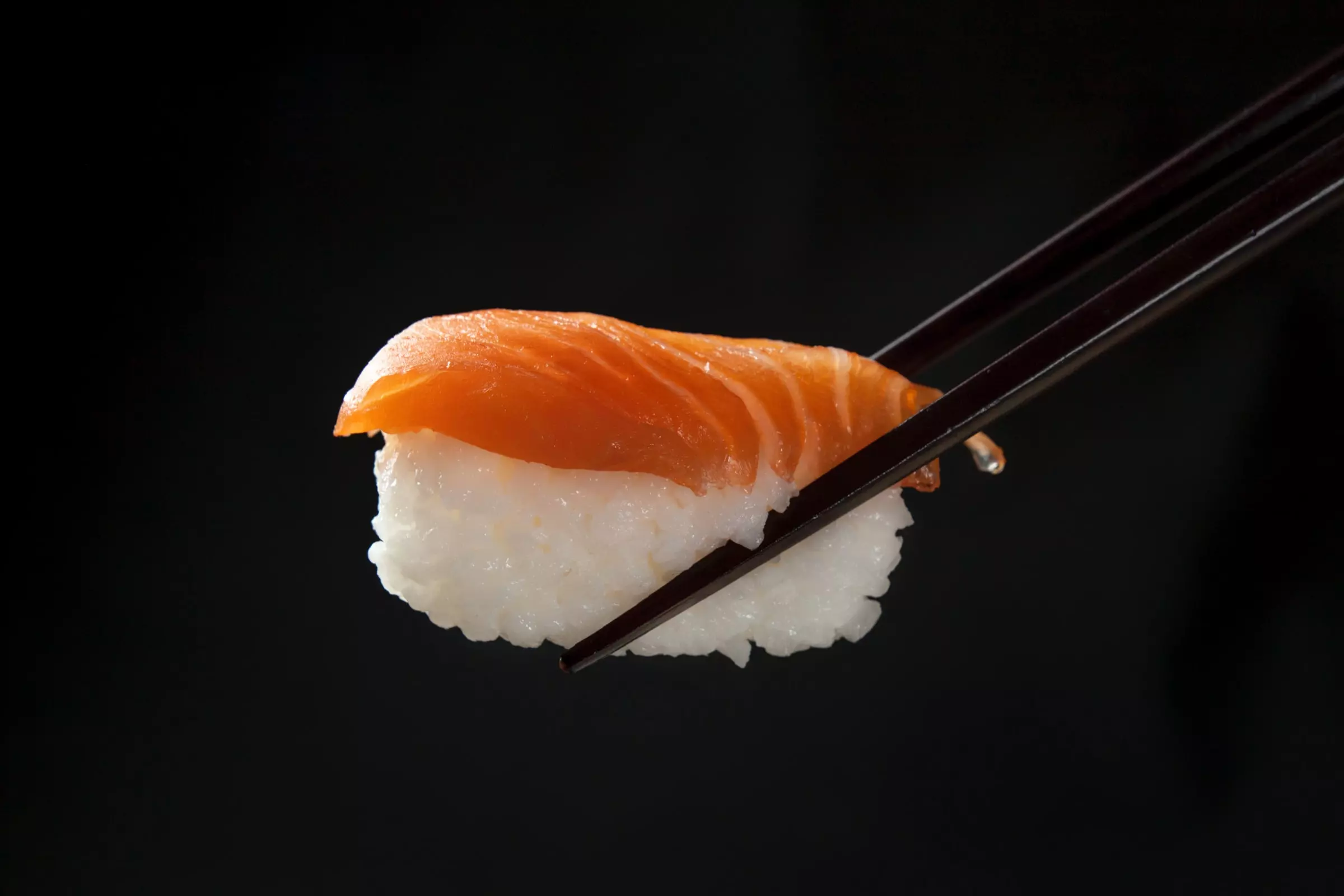Detailed content of our market study
 Inforamtion
Inforamtion
- Number of pages : 35 pages
- Format : Digital and PDF versions
- Last update :
 Summary and extracts
Summary and extracts
1 Market overview
1.1 Definition and scope of study
Sushi is a Japanese dish combining shari (sticky rice prepared with vinegar) and neta which is the rice’s topping and is most often raw fish.
There are different types of sushi, most being one of the following :
- Makis : a small roll wrapped in seaweed
- Temaki : similar to the maki but in the form of a cone (a variety that is pretty popular in Brazil as there are restaurant chains serving almost exclusively sushi cones)
- Nigiris : a slice of raw fish on top of an oval-shaped rice ball
Sushi restaurants worldwide experienced an increase in revenues of 21% between 2012 and 2018 riding on the rising popularity of the dish around the world and on the continuous growth in Southeast Asia and North America. Once a food found only in specialised restaurants, nowadays sushi is increasingly distributed in supermarkets, shops and in Brazil, they are also commonly offered in churrascarias (the country’s traditional all you can eat steakhouses).
Brazil has a very large Japanese community (there are over one and a half people of Japanese descent in the country according to the Ministry of Tourism) and some cities like São Paulo have entire neighbourhoods dedicated to the relationship between both countries. Living in such a melting pot of different cultures, Brazilian people often put their own spin on foods and traditions coming from foreign countries, creating opportunities in every market that can’t be found elsewhere (such as the aforementioned sushi cones i.e.). This is why it isn’t uncommon to find cream cheese or tropical fruit in sushis in Brazil, people don’t have as much interest for doing things in the traditional as you would expect in other countries.
This study will also give an insight on how the impact COVID-19 has had on this market and how things are looking as Brazil looks to get past this global pandemic.
1.2 A dynamic global market
Sushi is strongly rooted in Japanese culture, which subsequently has a positive effect on the revenue generated by the industry. These revenues were slightly impacted by the crisis between **** and **** losing *% of their total value over that time span since households were more reluctant to go to restaurants, especially since sushi is on average a more expensive choice of food. However, since ****, sushi restaurants income has been rising as it increased by **% from then until **** (***) [***].
Revenus générés par la consommation de sushis Japon, ****-****, trillions de yen CAGR: *,*% Source: ****
In ****, there were around *** *** Japanese restaurants outside of Japan whereas according to a report by NHK, taken up by Forbes, the number of Japanese restaurants in the world was only ** *** in ****, showing how this market grew at a very high pace. The main hubs for these restaurants are Asia (***). A lot of these restaurants are fairly new, as competition in the sushi market intensifies, and in the two years between **** and ****; the number of such restaurants grew by **%, mainly thanks to South-eastern Asian countries. [***]
Number of japanese restaurants by geographic zone World, ****, number of restaurants Source: ****
1.3 The Brazilian Market
The promise and growth the market shows on a global scale also hold true in Brazil. According to the Brazilian Franchisees Association (***). [***] This estimate does however have its flaws since the Japanese dish can be found in many other types of restaurants that aren’t specialised in Asian cuisine and are also increasingly present in supermarkets. We can thus only imagine that the sushi market is larger than this figure nationwide.
The Brazilian sushi market can also count on a flourishing context for restaurants. Despite national economic difficulties, revenue generated by restaurants and bars grew *.*% between **** and ****, reaching ***.* billion reais nationwide. [***] Catering business have been growing every year in Brazil for the past * years as the offer in big cities is getting more and more diverse and the smaller, more rural parts of the country are beginning to present new opportunities as they develop.
Catering Businesses Market Size Brazil, ****-****, in billion reais Source: ****
1.4 COVID-19 Impact
Even though it is still a bit early to know just how Covid-** has impacted the sushi market in Brazil, there are a few indicators that can help at least have an idea of what happened. As it relies heavily on the activity of restaurants the sushi market has taken a hit. Even though there was no lockdown commissioned by the national government, many cities and regions decided to do a total quarantine on the orders of local authorities. Most regions did just that during the course of the month of May. There is also the fact that even without a lockdown a lot of people don’t feel comfortable going to public areas such as restaurants to this day. As of June ****, the Brazilian Bars and Restaurants Association said that the industry had lost over a million jobs due to the crisis and a pessimistic estimate from the same institution said that up to **% of all restaurants and bars may have to close due to the crisis. [***] This is not only due to the loss of clients since in Brazil a lot if not most restaurants offer delivery (***) but also do to inflation and the decrease of the value of ...
2 Demand Analysis
2.1 Brazilian Eating Habits
At first look, it would look like Brazilian people aren’t really built for the sushi market. Their favourite type of food is meat, having the *th biggest consumption per person per year in the world (***) and the more you go South the more people eat red meat. That is why there can be such differences between two states such as Rio Grande do Sul, where the average is at *kg of fish and seafood per year and the Amazonas where that figure is at ** kg per year.
Despite these habits, things are looking up for fish and sushi. When comparing meat and fish consumption in the country through the years, meat is trending downwards (***), fish and seafood took a hit due falling back to *.** kg in ****. Ever since, it has started growing back every year and all points to that trend continuing as Brazilian people look to switch to a healthier lifestyle.
Fish and Seafood Consumption Brazil, ****-****, in kg per year per capita Source: ****
churrasco
feijoada
**% of people declared that Asian food is their go to option
Favorite types of restaurants when eating out Brazil, ****, by % Source: ****
2.2 Consumer Behavior and Preferences
Opinion Box conducted a survey in **** to better understand consumer behaviour and preferences in Brazil in regard to eating giving some helpful insight that can be used for the sushi market.
First off, a couple of things point to the opportunities the sushi market presents. **% of people declared eating out more often than in a typical week, showing how Brazilian people are attached to restaurants, bars and snack shops. Furthermore, **% of respondents said they were not satisfied with their eating habits and wanting to change them, giving reason to believe that people will continue to opt more often for fish and seafood instead of red meat. Another positive fact coming from this survey is that it showcased the importance of rice in the eating habits of the country: **% of Brazilians eat it every day, and sushi offers them just that.
The survey also shares information about the key criteria of Brazilians when buying food. The first factor that showed up was price, **% of people taking it into account when buying their food at supermarkets or in restaurants. The second most important category was flavour, with **% of people taking it into account. Another interesting thing is that **% of people said they wanted ...
2.3 Particularities of the Brazilian Market
As mentioned before the Brazilian sushi market is very particular in the sense that it offers many more opportunities than just traditional sushi as we know it. First off in the fish that is used, even though we consider the country as a whole, the two most popular types are salmon and tuna (***), some regions are very attached to their local fish such as in Pará, where these two kind don’t even appear in their top ** favorite fishes. Brazil has an enormous variety of fish and it opens doors for new types of sushi and new flavors that aren’t available elsewhere in the world. [***]
The other fact of the matter is that Brazilian people don’t hold tradition in such a high regard and would rather put their spin on foreign dishes to please them better. Brazilian taste is much more oriented towards seasoning than in Japan, and people compensate the lack of seasoning in Japanese rice by using much more soy sauce than in other countries. Wasabi is on the other hand less utilized on average. [***]
Also, since sushi can be found in so many types of restaurants (***) there are many unique types that have flourished in the ...
3 Market structure
3.1 The Origins of the Fish
Brazil is without a doubt a huge producer of fish and seafood, fishing a total of *** *** tons of produce in **** that generated around * billion reais and this market only increases every year, with the country’s total production increasing **% over the last * years. Unfortunately, this doesn’t translate to the sushi market due to the type of fish that are cultivated. **% of the country’s production is tilapia fish, which can be used for sushi but aren’t the most popular order. Another **% of the fish are of a native kind, which don’t include salmon or tuna. That just leaves *% of the country’s total fishing for all other kinds. [***]
This means that most of the fish that is used in sushi in Brazil is actually imported, which isn’t surprising considering that **% of the total fish consumption in the country is of imported fish. If we take in consideration salmon for example, almost all of it is imported from Chile and some from Norway. This can be a problem for the industry since Chilean salmon is farmed, and don’t present the same nutritional value as wild salmon. [***] Tuna on the other hand can be found on the Atlantic ...
3.2 The Dominance of Franchises
The sushi market in Brazil is made up of thousands of players, ranging from restaurants to supermarkets to even select gas stations. This makes for a very fragmented market where it is difficult to amass market shares. To have an idea of this tough competition, in São Paulo today, there are more sushi restaurants than churrascarias, showing just how popular the food has become. This also is why franchises (***) are those who dominate the market. Their ability to multiply selling points by selling out licenses allows them to be present around the country and also give an opportunity for the managers to start their restaurants with brands that already have recognition and a reputation. As a result, close to two thirds of the revenue generated by the industry comes from franchise restaurants. [***]
Here are the numbers behind two sushi chains in Brazil, to see what kind of investment opening a franchise can represent :
4 Analysis of the offer
4.1 Prices
Prices vary a great deal depending on the quality of the sushi and of the region or city you find yourself in Brazil. To have a general idea of what prices can be, here is a comparison between three chain restaurants in Rio de Janeiro for typical products :
Source: ****
4.2 Different Types of Dishes
The Brazilian market includes all the traditional sushi known around the world, such as but not limited to :
Makis : sushi in the form of a roll wrapped in seaweed Temakis : the preparation is similar to maki, in the form of a cone Nigiris : Slice of raw fish laid on an oval-shaped rice ball California Rolls : a maki that contains avocado, crab and cucumber Spring Rolls Tatakis : slice of fish very lightly cooked and marinated in vinegar Chirashis bowl of rice with assorted toppings Tempuras : seafood or fried vegetables Onigiri : Triangle shaped rice with filling
These dishes can be paired with a variety of ingredients such as :
Avocado Sake : salmon cut into pieces Ebi : shrimps and mayonnaise Ninjin : finely chopped carrot Kappa : cucumber (***) Kampyō : dried pumpkin strips Nattō: fermented soybeans Okra Oshinko Takuan (***) pickled radish Tamago omelet Tekka : tuna Tofu Ume : Umeboshi paste (***)
As mentioned before, there are some types of sushi very particular to the Brazilian market :
Hot Philadelphia : Salmon and cream cheese roll with bread crumbs on the outside Dessert Sushis : there are a lot of different ways to do this, such as using crepe batter to round out banana and chocolate in the shape of a sushi
5 Regulation
5.1 A tougher regulation to avoid sanitary issues
Being a type of food that is most often raw, sushi sales have a whole set of hygiene protocols and health regulations on top of the usual rules for restaurants and bars, such as :
Sushis and similar dishes must be prepared and assembled in an isolated, exclusive and air-conditioned area, in order to guarantee the recommended temperature of the raw material and food by the manufacturer and by the legislation in place. Companies must have at their disposal the necessary measuring instruments for the control of the productive processes performed in their facilities, such as scales, pHmeters and thermometers. The surfaces of trays, food boats, spice mixing bowls, molds for oniguiri, oshibako, bowls and cutting boards must be smooth, waterproof, washable and free from roughness, cracks and other imperfections that may compromise their hygiene and be sources of food contamination. The reception of raw materials, ingredients and packaging must be done in a protected and clean area, physically separated from the handling areas.
The whole judiciary texts concerning preparation and sale of sushi can be found on the following link.
6 Positioning of the players
6.1 Segmentation
* : Owners of Gendai and China in Box
* : Owners of Jin Jin Wok, Jin Jin Sushi and Little Tokyo but also of many other franchises that are not a part of this market
- TrendFoods
- Jin Jin Suhsi
- Makis Place
- Koni
All our studies are available online in PDF format
Take a look at an example of our research on another market!
 Choosing this study means :
Choosing this study means :
Access to more than 35 hours of work
Our studies are the result of over 35 hours of research and analysis. Using our studies allows you to devote more time and added value to your projects.
Benefit from 6 years' experience and over 1,500 industry reports already produced
Our expertise enables us to produce comprehensive studies in all sectors, including niche and emerging markets.
Our know-how and methodology enable us to produce reports that offer unique value for money.
Access to several thousand articles and paid-for data
Businesscoot has access to all the paid economic press as well as exclusive databases to carry out its market research (over 30,000 articles and private sources).
To enhance our research, our analysts also use web indicators (semrush, trends, etc.) to identify market trends and company strategies. (Consult our paying sources)
Guaranteed support after your purchase
A team dedicated to after-sales service, to guarantee you a high level of satisfaction. +44 238 097 0676
A digital format designed for our users
Not only do you have access to a PDF, but also to a digital version designed for our customers. This version gives you access to sources, data in Excel format and graphics. The content of the study can therefore be easily retrieved and adapted for your specific needs.
 Our offers :
Our offers :
the sushi market | Brazil
- What are the figures on the size and growth of the market?
- What is driving the growth of the market and its evolution?
- What is the positioning of companies in the value chain?
- Data from several dozen databases
5 reports pack (-15%) BR Brazil
- 5 reports at €75.6 excluding VAT per study to choose from our Brazilian catalogue for 12 months
- Save 15% on additional studies purchased
- Choose to be refunded any unused credit at the end of the 12-month period (duration of the pack)
See the terms and conditions of the pack and the refund of unused credit.















